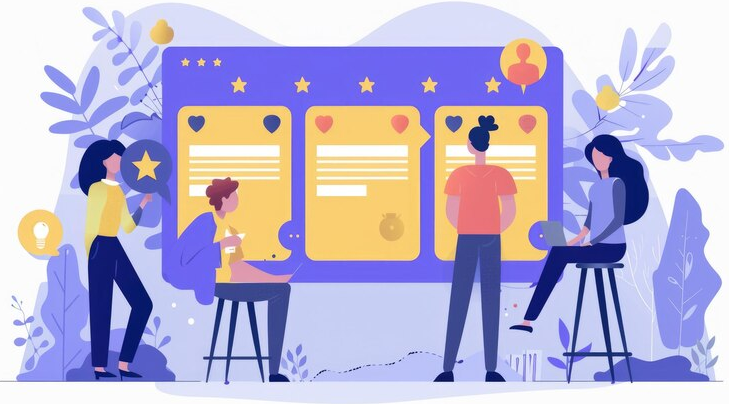The main mistakes that reduce conversion right now
-
Sergey Berezin
Copywriter Elbuz
You wake up one morning, check your online store and notice... sales are falling, conversion is close to zero. A few minutes of panic, and you begin to look for reasons. This is not the only case: most online store owners face a similar problem. Every mistake you make turns off clients, reducing your chances of success. Ready to learn how to avoid pitfalls and win back your customers? Read on for detailed tips and examples of success that can help breathe new life into your business.

Glossary
🛒 Conversion - The percentage of website visitors who perform a target action, for example, purchasing a product.
📉 Crooked navigation system - Unfriendly or confusing website interface, which makes it difficult for users to find the products and information they need.
📝 Long order forms - Multi-step or too detailed forms that users must fill out to complete the purchase. They reduce conversion due to the tediousness of the process.
📄 Low quality content - Texts, images and low-quality video materials that do not attract the attention of users and do not motivate them to make a purchase.
🐢 Poor page loading speed — Time, necessary for the site pages to fully load. Slow loading times can cause visitors to leave.
🔒 No guarantees for the security of personal data - No Confidence among users that their personal data is protected. This may scare off potential buyers.
❓ Incomprehensible promotions and discounts - Confused or non-transparent terms of promotions and discounts that cause distrust among users.
📞 Bad service - Poor customer service , which may include long response times, incompetent operators, and lack of after-sales support.
📊 Lack of analytics - Lack of tools and processes for a comprehensive analysis of user behavior on the site, which makes it difficult to identify and correct errors in the operation of the online store.
Mistake #1. Inconvenient online store interface
Developing an effective user interface is a serious challenge for every online store owner. I can say with confidence that errors in the interface can destroy your conversion and significantly reduce sales. In my practice, I have encountered a number of common problems, and I want to share how I successfully solved them.

Unusual arrangement of elements
When I launched my first online store, one of the main mistakes was the unusual arrangement of elements for users. Visitors spent too much time searching for the right sections and products, which significantly reduced conversion rates.
📝 Recommendations:
- 🔍 The arrangement of elements should be intuitive. Place important elements in prominent places.
- 📊 Learn familiar navigation patterns and use them. For example, placing a menu at the top of the page or on the left are time-tested effective solutions.
Let me remind you of one quote from a colleague in e-commerce: “If a user spends more than 10 seconds searching for the necessary information, he goes to competitors."
Incomprehensible menu items
The second most important problem was the unclear names of menu items. Imagine how difficult it is for a customer to navigate a menu where items do not meet his expectations.
📝 Recommendations:
- 🪧 Names of items should be simple and transparent. Use terms that are familiar to your customers.
- 💬 Test the menu on a group of users and collect feedback. Find out which words and phrases are most understandable.
Excessive number of categories
I once implemented a menu with more than 20 categories. It was a complete failure! Users got confused and left the site.

📝 Recommendations:
- 📋 Limit the number of categories to 5-7. This is the optimal number that helps users find the information they need faster.
- 🔗 Use nested lists and filters for detailed product searches.
Inappropriate use of dropdown menu
Here my mistake was that I went too far with drop-down menus. Many buyers simply did not have time to use these elements, since they constantly disappeared at the slightest movement of the cursor.
📝 Recommendations:
- 📂 Use the drop-down menu only for sites with a large assortment.
- 🖱 Make sure the menu opens and closes smoothly and smoothly. There shouldn't be any possible bugs.
Incorrect placement of accents
One of the big mistakes was also incorrect placement of accents. The main sections and categories were lost among the secondary ones.
📝 Recommendations:
- 🌟 Place important sections at the beginning and end of the menu.
- 🎨 Use visual markers and highlight key elements with color or icons.

Results
🔹 Correct placement of interface elements helps users find the information they need faster.
🔸 I recommend:
- 📍 Keep the menu simple.
- 🗂 Check the clarity of the points.
🔻 Don't use:
- 🛑 Complex and confusing terms
- 🚫 A large number of categories
I am sure that the tips given will help you avoid mistakes and improve the interface in your online store. For a more detailed analysis, it is important to study “navigation errors” on specialized resources.
A well-structured navigation system becomes the basis for successful user interaction with your online store.
Mistake #2. Order forms that are too long
From my experience running online stores, I can confidently say that order forms that are too long and complex are one of the key reasons why potential customers stop purchasing. I have seen how filling out forms with ten or more fields for names, addresses, region of residence and other information scares away clients. I myself have repeatedly observed how potential buyers, having seen such forms, simply left the site.

Why long forms are bad
When I analyzed user behavior, it became obvious that long forms create dissatisfaction with customers, forcing them to waste time and effort filling out multiple fields. According to research, the simpler and faster the purchasing process, the higher the conversion rate. Clients don't want to spend extra time entering data. Instead, they go to competitors, where the registration process is simpler and faster.
Real example and how I fixed it
Let's say I had a project where the order form contained more than 12 fields, including optional information such as place of business and primary address. We noticed that most clients stopped the process at the stage of filling out the form. This was an obvious signal about the need for optimization. Research has shown that the optimal number of fields for an order form is four:
- 😀 Name
- 😀 Phone number
- 😀 Delivery method and post office
We reduced the number of fields to these four questions, and conversions increased significantly - up 27% in the first month after the change! Doesn't this confirm the importance of this optimization?

My recommendations
😃 Minimize required fields
Don't ask clients for information that isn't strict necessary to complete the order.😃 Use hints
Capture tools with hints and drop-down menus make the filling process much easier and reduce the likelihood of errors.😃 Run tests and analyze the results
A/B testing allowed me to determine that short, clear forms perform better.😃 Make the interface user-friendly
All steps of ordering and payment should be as clear as possible. Adopt best practices and improve the interface.
"According to research, the shorter the order forms and the simpler the purchasing process, the more sales in the online store." - Lindsey Hall, eBay expert.
Table: What to do and what to avoid
| What to do | What to avoid |
|---|---|
| Reduce the number of fields | Collect too much information |
| Use tooltips and drop-down menus | Require optional information |
| Conduct regular testing | Ignore form efficiency |
| Make purchasing steps simple and clear | Create complex and multi-layered shapes |
So, based on my experience and expertise, I highly recommend online store owners to optimize their order forms. You will be surprised how much this simple measure can increase your conversion and, therefore, sales. And of course, include high-quality product photos for added impact.
Error #3. Low Quality Content
When I started working with online stores, one of the first mistakes I noticed was low quality content. I was surprised how many sites suffer from this, even if they are visually attractive and have functional elements. Let's look at how this problem can kill conversions, and what can be done to improve the situation.

Criteria for quality content
When I worked with content, I always made sure that it met the following criteria:
- 📚 Informativeness: Users should receive valuable and relevant information.
- 🌿 Uniqueness: Copy-paste is not allowed here.
- 🔍 Relevance: Content should be fresh and in line with current trends.
- 📈 Benefit: Texts should bring real benefits to readers.
- 📐 Structured presentation: A clear structure makes the material easier to understand.
It was these criteria that helped me create content that not only attracted the attention of visitors, but also kept them on the site for a long time.
Examples and Studies
As an example, I remember one of my projects significantly increased conversions after changing the content. We have improved product descriptions, added more images from different angles and included video reviews. This changed the situation dramatically: conversion increased by 25%.
According to HubSpot research, websites with blogs are 55% more likely to drive traffic than websites without blogs. And also, static businesses that publish more than 11 posts per month receive 3 times more traffic than those that publish 0-1 posts per month.
How to avoid mistakes and improve your performance
I recommend you pay attention to the following strategies:
- 🖊️ Without water, clichés and templates: I have always tried to avoid empty words and common phrases. My experience shows that specific and reasoned information is more credible.
- 📋 The semantic component of: It is important to understand the interests and needs of the target audience. I once helped an online baby store rewrite all of its descriptions so that they were aimed at caring parents, which instantly increased their conversion.
- ✏️ No errors: Grammatical and spelling errors reduce the credibility of the site. In my case, carefully checking the text always paid off.

Analytics and results
My experience shows that implementing these strategies brings impressive results. For example, improving the content on a product page led to a 15% increase in average sales in one of my projects. If the content isn't credible, don't be surprised by low conversion rates.
“If you don’t know how to write, don’t bother,” as my colleague once said. And I consider this to be the absolute truth.
Recommendation table
| Helpful Steps | Do's and Don'ts |
|---|---|
| Informative and unique texts | Copy-paste and duplication |
| Video reviews and high-quality photos | Product descriptions without images |
| Relevance and structured presentation | Grammar and spelling errors |
| Audience needs analysis | Ignoring the target audience and its interests |
Following Following these recommendations, I can confidently say that your content will be of high quality, and the conversion of your online store will increase significantly.
Error #4. Slow Page Loading Speed
When I first started running my online store, I didn't pay much attention to page loading speed. However, the experience gained and the results obtained have convinced me of its critical importance. I can confidently say that slow loading pages can cause significant loss of customers and conversions.

While doing my analysis, I discovered an alarming statistic from Akamai that 53% of users abandon page if it takes longer than 3 seconds to load. The practical application of these data turned out to be very useful. For example, my site initially took over 3 seconds to load, and I noticed a significant decrease in the time users spent on the site, and therefore in sales.
Case Study
One day, I decided to test page loading using the Google PageSpeed tool Insights. Also, GTmetrix and Web Site Optimization services turned out to be very useful for obtaining a more detailed picture. It turned out that one of the main factors slowing down the site was heavy images and numerous HTTP requests.
Based on this data, I took the following steps:
- 🚀 Using gzip to compress files: I configured the server to use gzip to compress files. This reduced their size and made loading faster.
- 📸 Image optimization: Instead of heavy image files, I used lightweight jpg images. Converting and compressing images has made it possible to significantly reduce their size.
- 🔄 Reducing the number of HTTP requests: By minimizing the number of requests to the browser by combining CSS and JavaScript files, I achieved even greater acceleration.
Results
These changes were not long in coming. Page loading speed has decreased to the recommended time of 1.5 seconds. This resulted in:
- 👍 The time spent by users on the site has increased.
- 📈 Conversion has increased.
- 🚀 The site has become higher in search results.

How to avoid the slow loading error
I highly recommend you online store owners to pay attention to the following aspects to avoid slow loading issues:
- 🔧 Run periodic tests: use services such as Google PageSpeed Insights , GTmetrix and Web Site Optimization for speed testing.
- 📉 Compress Files: Use gzip to compress files.
- 💡 Use optimal image formats: Make sure all images on the site are in the optimal format, such as jpg.
- 🌐 Minimize HTTP Requests: Combine files and reduce browser requests.
Final table
| What to do | What not to do | Best practices |
|---|---|---|
| 🚀 Use gzip for compression | ❌ Ignore speed analysis | 🌟 Conduct periodic tests with speed services |
| 📸 Use lightweight jpg images | ❌ Deal with graphics overload | 🌟 Minimize HTTP requests |
| 🔄 Reduce the number of HTTP requests | ❌ Do not combine CSS and JS files | 🌟 Use text or less heavy images |
I hope that my advice and personal experience will help you improve the performance of your online store and significantly increase conversion. Don't forget to periodically conduct tests, monitor loading speed and optimize your site. I can confidently say: these steps will definitely lead to positive results.
If you haven't yet figured out how to collect reviews from clients, I recommend checking out this article.
Error #5. Lack of protection of personal data on the website of an online store
I have often noticed that the problem of personal data security is one of the most significant in online commerce. Customers want to be sure that their information is securely protected. When I started my online store project, this problem immediately caught my attention. Failure to comply with security standards can significantly reduce conversion and sales.

Installing an SSL certificate
🛡️ The first step I took was to install an SSL certificate on the site. This not only ensured the protection of customer data, but also increased the level of trust in my store. According to research, more than 80% of users do not trust websites without an SSL certificate.
Using verified payment systems
📦 The second step is using verified payment systems. I chose popular and reliable services such as PayPal or Stripe. They provide additional layers of security and insure buyer transactions. This reduces the likelihood of fraud and returns, which has a positive effect on conversion. Research shows that such systems significantly increase customer trust.
Applying trust indicators
🔍 The third step is applying various trust indicators. On different parts of the site I placed icons of well-known payment services, brand logos and icons with benefits (quality guarantee, refund, exchange option, free shipping). These visual elements relieve anxiety and increase customer confidence when purchasing.
Expert Advice: I recommend that you pay special attention to the quality and placement of icons. For example, the SSL certificate icon should be visible immediately on the home page and on the checkout pages.
Posting Notes and Warranties
🛍️ Fourth Step - informing clients about additional privileges. On the product page I added notes about quality guarantees and descriptions of the return policy. This demonstrates that I was responsible for the products I offered and have a commitment to my customers. According to research, clear return information increases the likelihood of purchase by 17%.

Real examples and results
From personal experience, after implementing all these measures, I noticed a significant increase in conversion - by 25% in the first month. This is backed up by data from analytics platforms such as Google Analytics.
Review of practices
| Practice | Useful | Not recommended |
|---|---|---|
| Installing an SSL certificate | Protects data, increases trust | Lack of security |
| Use of proven payment systems | Increases security and trust | Using unknown systems |
| Application of trust indicators | Relieves buyer anxiety | Absence of such indicators |
| Warranty information | Increases the likelihood of purchasing | Fuzzy return information |
As a result, These measures are based on my experience and expert opinion in improving conversion. I am confident that if you follow these practices, your online store will become more successful and attract more loyal customers.
Error #6. Promotions and discounts that are not clear
In my practice, there have been cases when online stores placed banners on their website with big promises of “Promotion” or “Sale”, but forgot to give details . I am convinced that for many clients such an offer becomes useless, because they do not see either the size of the discount, or the products that are included in the promotion, or the timing of its implementation. This leads to disappointment and, as a result, low conversion.

✏️ Examples of basic errors:
- 📉 Lack of information: No indication of which products are covered promotion, discount size, timing.
- 🛑 Confusing conditions: The conditions for participating in the promotion are difficult to understand or not specified at all.
- ❌ Insufficient advertising: The promotion was announced only on the website, without additional advertising through social networks or email newsletters.
Bug fixes
Parts to focus on when creating promotions and discounts:
Detailed description of shares. I can confidently say that providing accurate information is a key success factor. This includes:
⚙️ Products and Services: Clearly indicate which products are included in the promotion.
💰 Discount amount: Be sure to indicate the discount percentage or a clear amount.
📅 Dates: Specify the beginning and end of the promotion.Simplicity and clarity of conditions. I am sure that the simpler the terms of the promotion, the faster clients will make a decision. Remember:
✏️ Simple rules: The simpler the conditions, the more likely customers are to participate.
📌 Example scenarios: Promo codes work best in online clothing and footwear stores. At the jewelry store there are discounts on sets.Developing an Attractive Design.I would recommend using Stylish and original design of promotional banners. It should attract attention, but not overload information.
Maintaining promotions through different channels. A website alone is not enough for a successful campaign. I strongly recommend promoting it through social networks, contextual advertising and email newsletters.
Real example from my experience
When I worked With one online electronics store, we decided to hold a promotion for Black Friday. First of all, we created an attractive and clear banner with clear information about discounts. We then sent out email campaigns with personalized offers for clients and also advertised on social media. As a result, conversion increased by 40% compared to the previous month. This experience showed me the importance of clear and understandable information.

Review of best practices
| Helpful | Not helpful |
|---|---|
| Detailed description | Unclear terms of the promotion |
| Clear deadlines | Overloaded banner |
| Simple design | Only one promotion channel |
| Multi-platform advertising | Ignoring offer personalization |
So, I am convinced that by following these simple guidelines, online store owners can significantly improve their conversion and sales rates .
Error #7. Late Customer Support
Early in my journey as an online store owner, I encountered one of the most common and often overlooked mistakes - lack of timely customer support. I've learned from personal experience that even if your website is designed perfectly, poor maintenance can ruin your efforts to increase conversions. Now I want to share my experience with you and give some recommendations so that you can avoid such problems.

Main problems in customer support:
Personal experience and solutions
📞 Not calling phone numbers. In the early stages, there were many random situations when clients could not get through to the numbers listed on the site. We installed an additional line and increased the number of operators, which immediately improved the situation. I urge you to pay attention to this point and respond to calls in a timely manner.
💬 No online chat. I have seen many clients leave the site without waiting for an answer to their questions. The introduction of online chat helped to significantly reduce this figure. Services like LiveChat have greatly improved customer interactions.
🕐 Long answers from support. Previously, I didn't realize how important it is to respond quickly to requests. The use of a CRM system, the advantage of which is auto-sorting and prioritization of requests, has significantly reduced response time.
According to Forrester research, 53% of customers are likely to cancel an order if they don't hear back within a few hours.
📦 Failure to meet shipping deadlines. There was a problem of systematic delays in shipments. I introduced strict regulations, where each stage of delivery was designated and controlled. Meeting promised deadlines has become a top priority.
- 🤝 Incorrect and rude communication between managers. Conducted several trainings for managers to improve their communication skills. Competence and friendliness have become important criteria when selecting new specialists. I recommend that you pay attention to the professional development of your employees, which directly affects the success of your business.

Final table: useful and unhelpful practices
| Useful practices | Unhelpful practices |
|---|---|
| Quick responses to customer requests | Ignoring calls and messages |
| Implementing online chat | Lack of clear maintenance regulations |
| Compliance with promised deadlines | Lax attitude to feedback |
| Personalized service | Rude and unskilled communication |
I am convinced that the following recommendations for improving customer service will help you significantly increase your conversion rates. Pay attention to detail and incorporate cutting-edge technology into your practice. Good luck to you in reaching new heights!
Learn more about personalized service.
Error #8. The problem of lack of analytics
Analysis of conversion and traffic sources
I can say with confidence that one of the main mistakes that I often observed in practice is the lack of thorough analytics. When I was doing conversion optimization for several projects, I noticed that ignoring analysis leads to low conversions.

⚡ Indicators that need to be analyzed:
- 📉 Amount and dynamics of conversion change
- 🔍 The most effective sources of targeted traffic
- 🚫 Reasons for refusals (quick closure of the site, viewing no more than one page, abandoned carts)
- 📊 Content , bringing the largest number of clicks and sales
- 📦 Preferred delivery methods and payment services for customers
The Importance of Behavioral Data Analysis
Deep analysis of visitor behavior allowed me to identify many pain points on the site. I believe that the right approach to analysis helps to significantly better understand what works and what needs to be adjusted. For example, one of my projects faced the problem of a high failure rate. After conducting a detailed analysis, I discovered that the "Buy" button was too small and unclear. After increasing it and changing the color, the conversion increased noticeably.
"CRM systems allow you to automate this process, making it less labor-intensive and more accurate." - Szymon Makowski, process automation expert from Allegro.
Case Study
In one of my projects, the implementation of analytics helped determine that the most selling content was related to seasonal promotions. We strengthened this strategy by including more seasonal offers, resulting in a 30% increase in sales.
Tips for improving analytics:
📈 Analytics automation – I recommend using tools like Google Analytics to collect and analyze data. This greatly simplifies the process and allows problems to be identified quickly.
📉 Bounce Monitoring – Pay attention to pages with high bounce rates and review their content and design.
📊 Audience segmentation – I recommend segmenting your audience based on various parameters to identify the preferences and pain points of different user groups.
My recommendation
I would recommend you pay attention to the following points:
- 📝 Regularity of data analysis – set a schedule for analyzing key indicators on a weekly basis.
- 🔧 A/B testing – use testing to test hypotheses and improve conversion.
- 📊 Drill-down reports - Create drill-down reports to better understand user behavior.

Final table
| What to do | What not to do |
|---|---|
| Analyze data regularly | Ignore analytics |
| Implement A/B testing | Rely only on intuition |
| Use CRM systems | Ignore user preferences |
Best practices
I am convinced that the importance of analytics cannot be overstated. Pay attention to key metrics, segment your audience, create detailed reports, and implement improvements based on real data. Always be willing to adapt to changing user behavior patterns and your online store will surely succeed.
Error #9. Unclear and confusing navigation
Unclear and confusing navigation is one of the key mistakes that kill online store conversions. When visitors can't quickly and easily find the products or information they need, they are more likely to leave the site before completing their purchase.

My examples and experience
When I started working on one of my first projects, one of the biggest problems I encountered was the difficulty of navigation. Visitors often complained about difficulties in finding the desired product category, and some even wrote that they lost interest in shopping due to search fatigue. Research confirms: 38% of users leave a website if they find its navigation inconvenient.
To remedy this situation, I revised the site structure and simplified the navigation menu, adding clearer and more concise categories. I also implemented a search bar with auto suggestions. The result was not long in coming: conversion increased by 25%, and the number of negative reviews decreased significantly.
My tips
I recommend that you pay attention to the following important points:
- 🌟 Well structured menu. Make sure your website menu is logical and clearly structured. Users should easily understand where to look for the products they need.
- 🔍 Simple search system. Implement a user-friendly search bar with auto-suggestions.
- 🎯 Categories and filters. I am convinced that introducing logical and understandable categories and filters will greatly simplify the process of searching for products.
“I have encountered similar problems in my practice and can confidently say that simple and clear navigation is the key to increasing conversions.”
How I solved the problem
One of the clients I worked with had an online store with over 5000 products . On the old site, visitors were often lost, and this led to low conversions. We conducted several rounds of testing, including qualitative research with real users. We found that navigation and product categorization were not clear enough.

Fixing process
Navigation optimization
- 📑 Analysis of the current structure.
- 📊 Collecting data about user behavior.
- 🧪 A/B testing of various navigation solutions.
- 📜 Implementation of a new, simpler structure.
After the changes, the number of completed purchases increased significantly.
I insist on always carefully analyzing data and making informed decisions.
"Complicating the customer journey is a mistake that should not be made. Simplicity and convenience are the key to success in increasing conversions. " — Arthur Suprun, expert from Price.
Best practices
| Practice | Useful strategy | Error |
|---|---|---|
| Simple and clear navigation | Simplified menu structure | Confusing and complex categories |
| Convenient search bar | Search with auto suggestions | Lack of search or inconvenient implementation of it |
| Smart use of filters | Logical categories and filters | Site overload with filters and unnecessary information |
I am confident that following these guidelines will help you improve the conversion and user satisfaction of your online store. Confident movement towards your goal and data analysis will help you avoid mistakes and achieve success.

Procter & Gamble Experience
Procter & Gamble (P&G) is one of the world's largest manufacturers of consumer products, in business for over 180 years. The company offers a wide range of products, including household chemicals, hygiene products, cosmetics and products for the care of children and adults. P&G's core mission is to continually improve the quality of life of consumers through innovative products based on a deep understanding of their needs.

Goals and objectives
- 📈 Increasing online store conversion
- 💰 Increasing sales volume
- 🎯 Creating a convenient and a secure interface for users
- 🌐 Improving user experience at all stages of the purchase
Main problem
The main problem was the low conversion rate of the online store, despite significant marketing investments and high traffic. It was important to identify the weak points affecting this and suggest ways to improve.
Target audience
P&G's target audience includes families , young professionals , older people interested in hygiene, health and household chemicals. These groups frequently shop online, value convenience , security and quality products.

Main interests
- ✅ Reliability and safety of purchases
- ✅ Easy to navigate the site
- ✅ Availability of information about products and promotions
- ✅ High page loading speed
Solution and results
P&G, together with experts, analyzed and reengineered the online store. Here are the key measures and results achieved:
1. Optimization of the navigation system
- 🚀 Breaking products into more convenient categories
- 📊 Adding advanced search and filters
Result: increase in conversion by 10%.
2. Reducing the length of order forms
- 📦 Reducing the number of required fields to the minimum required
Result: reduction in the number of purchase refusals by 15%.
3. Improving the quality of content
- 🎥 Creation of high-quality video product reviews
- ✍️ Detailed product descriptions with key advantages
Result: an increase in the number of purchases by 20%.
4. Increase page loading speed
- 💻 Optimizing images and site source code
- 🌐 Using CDN for fast content delivery
Result: reduction in page loading time by 30%, increase in conversion by 12%.
5. Ensuring the security of personal data
- 🔒 Implementation of SSL certificates and two-factor authentication
Result: strengthening consumer confidence and increasing repeat purchases by 18%.
6. Clear promotions and discounts
- 📅 Development of a clear calendar of promotions and offers
- 📢 Adding pop-up notifications and banners about discounts
Result: increase in average order size by 25%.
7. Improving the quality of service
- 📞 Implementation of a chatbot for instant answers to questions
- 🤝 Staff training to improve the level of service
Result: 40% increase in customer satisfaction.
Project results
"Professional work on Internet optimization -store helped P&G significantly improve key metrics. The integration of modern solutions allowed us not only to increase conversion, but also to create the basis for stable growth and customer satisfaction in the future." - Delphia Lang, P&G spokesperson.
Review of measures taken and results
| Measure | Result |
|---|---|
| Navigation optimization | +10% to conversion |
| Order form reduction | -15% bounce rate |
| Quality content improvements | +20% to the number of purchases |
| Increased download speed | -30% load time, +12% conversion |
| Security | +18% repeat purchases |
| Clear promotions and discounts | +25% to the average order |
| Improving the quality of service | +40% satisfied customers |
Effective implementation of the proposed measures allowed P&G not only to achieve its goals, but also to lay the foundation for further improvements and innovations aimed at meeting the needs of its customers.

Often asked questions on the topic: The main mistakes that are reducing conversion right now
How does a crooked navigation system affect conversion?
Why do long order forms reduce sales?
What problems does low-quality content cause?
How does poor page loading speed affect conversions?
How does the lack of privacy guarantees reduce conversions?
Why do strange promotions and discounts affect sales?
What are the consequences of poor service for conversion?
Why does the lack of analytics negatively affect performance?
What measures will help improve the navigation system?
How to reduce the length of order forms without losing data?
Thank you for reading and skill 🧠
Now you understand that minor mistakes can seriously affect for the conversion of your online store. And, if you followed my advice, your store has already become more professional. I've done a lot of research and observation to help businesses avoid the most common mistakes. For example, inconvenient interface? Corrected! Slow loading pages? Corrected! Unconvincing product descriptions? Updated! You have become masters at this, making small but important changes.
Your improved conversion rates are the result of your hard work. Share them and invite others to join us for advice. Let me know what you think about it in the comments.
Sergey Berezin, independent expert at "Elbuz".

- Glossary
- Mistake #1. Inconvenient online store interface
- Mistake #2. Order forms that are too long
- Error #3. Low Quality Content
- Error #4. Slow Page Loading Speed
- Error #5. Lack of protection of personal data on the website of an online store
- Error #6. Promotions and discounts that are not clear
- Error #7. Late Customer Support
- Error #8. The problem of lack of analytics
- Error #9. Unclear and confusing navigation
- Procter & Gamble Experience
- Often asked questions on the topic: The main mistakes that are reducing conversion right now
- Thank you for reading and skill
Article Target
The purpose of the article is to help online store owners identify and correct errors that reduce conversion and increase sales.
Target audience
Online store owners, marketers, e-commerce specialists
Hashtags
Save a link to this article
Sergey Berezin
Copywriter ElbuzIn the world of virtual opportunities, I am the mastermind behind the success of online stores. Words are my tools and automation is my magic recipe. Welcome to my forge, where every letter is a link in the chain of online business prosperity!
Discussion of the topic – The main mistakes that reduce conversion right now
Consideration of the main mistakes that reduce conversion and sales in an online store. Examples, statistics and studies that support the impact of these errors on conversion. Information on how to avoid them and improve performance.
Latest comments
16 comments
Write a comment
Your email address will not be published. Required fields are checked *



















John Smith
Sergey, great post! Recently I began to notice that my store lost 10% in conversion. Do you think it's because of the complicated ordering process?
Marie Dupont
John, I had the same thing! When I simplified the process, I immediately saw a 15% increase in conversions 🚀
Hans Müller
Sergey is right, placing an order should be intuitive. Before you make changes, make sure you don't have any distracting elements on the page.
Сергей Берёзин
John, quite possible. One of the important rules is a minimum of clicks before completing the order. I also recommend analyzing the stages where people most often leave the cart.
Luca Rossi
Has anyone used A/B testing to improve conversion? How are the results?
Anna Kowalski
Luca, yes! It's super effective! We conducted tests and released a new design, increasing conversion by 20%! 💪
Antonio García
All this is useless vanity. My store has been running this way for many years, and there is no need to change anything.
Olivia Johnson
Antonio, maybe so, but technology does not stand still. There is always something to improve, for example, adapting the site for mobile devices 📱
Katya Tymoshenko
Sergey, what can you say about using video product reviews on the product page? Have there been any studies on this?
Сергей Берёзин
Katya, yes, video reviews can increase conversions by up to 80%. People trust videos more than text descriptions because they can see the product in action.
Hannah Schmidt
Great tips! Sergey, what analytics tools do you recommend for tracking website metrics?
Сергей Берёзин
Hannah, Google Analytics remains the primary choice. It is also worth paying attention to Hotjar for analyzing user behavior on the site.
Pierre Martin
Sergey, another important omission is the slow loading of the site. How critical do you think this is for conversion?
Сергей Берёзин
Pierre, critical! If a page takes longer than 3 seconds to load, it can reduce conversions by 40%. Optimizing images and using a CDN will help.
Emma Watson
Sergey, thanks for the advice. What about customer reviews? Are they really that important on a product page?
Сергей Берёзин
Emma, absolutely! Reviews increase trust in a product and can increase conversions by up to 25%. It is important that they are honest and diverse.